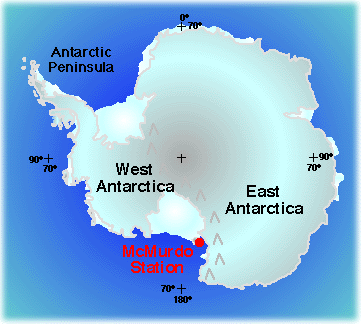
My name is Kolene Krysl, and I teach sixth grade science and reading at
Central Middle School in Omaha, NE. I am thirty-six years old and have
been teaching for thirteen years--six for Victor Elementary School
District in California and seven for Millard Public Schools in
Nebraska. I also sponsor the ski club, coach middle school basketball,
and coach high school softball and tennis. I graduated from Kearney
State College in 1987 with a degree in Elementary Education.
I have been teaching middle school science for four years now.
My goal is to make science come alive for my students. I enjoy the
inquiry-based
methods and research skills approaches to science. My interest in
Antarctica began after I conducted research on the T. Bernachii, an
Antarctic fish, with Dr. David Petzel at Creighton University as part
of the American Physiological Society's Frontiers in Physiology Program.
I completed my parcticipation in the research by March of 1999 and
traveled to the Experimental Biology Conference in Washington D.C.
to make a poster presentation.
In my spare time, I enjoy playing sports and parcticipating in outdoor
activities including softball, tennis, snow skiing, swimming, camping,
canoeing, hunting, and fishing. One of the most exciting things I've
ever done is help band Canada Geese with Dr. William Sladen with the
Airlie Migratory Birds Project during the summer of 1999. I consider
myself to be adventurous, and this is my biggest adventure to date. I am
excited about incorporating my experience into my curriculum and
sharing it with my students and colleagues.

Spacing and Group Dynamics of Weddell Seal Colonies
Donald B. Siniff, University of Minnesota
Weddell seals (Leptonychotes weddellii) occupy areas close to the
Antarctic continent in the early austral spring. In these areas the annual
ice remains stable late into the spring, and in locations where tidal cracks
occur, Weddells gather in colonies to give birth to pups and to breed.
Several colonies exist within the McMurdo Sound area, and these have been
the focus of research projects since the 1960's. The question of whether the
spacing of individual females in relation to access holes along the tidal
cracks limits the number of pups that can be produced at a given colony is
important to the study of Weddell seal population dynamics. The distances
between individual females with pups have been approximated in the past, but
no such measurements have been made with the new GPS technology.
Furthermore, the relationship between surface locations and under-the-ice
locations, where females "teach" their pups the art of swimming and foraging
have never been connected.
The project that I will be involved with will use
GPS and underwater television to correlate the spatial distances of mother
and their pups on the surface of the colony with their underwater locations.
Comparisons of these data with past studies and correlation with population
data will give insight to the role that spacing might play in limiting the
number of females that can give birth, and successfully raise her pup, in a
given colony situation.

